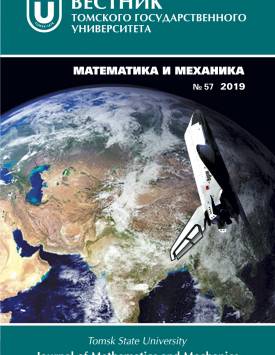Investigation of a carbon nanofabric permeability
The theoretical and practical experience of membrane transport shows that the selectivity of membrane increases with a decrease in its thickness at constant surface porosity. The nanowire stacked up in one or two layers determines the minimum thickness of the layer obtained on the basis of the selected structural element, i.e. nanowire. At present, only wires of a certain length and structure are synthesized. Synthesis of such materials as nanofabric is not yet completed. Leaving aside the experimental difficulties of producing such materials, we proceed to describe the passage of mobile particles through the nanofabrics. This work presents a study on the interaction of gas phase molecules and atoms with an ideal structure of two-dimensional stack of spherical diamond particles. The Rudyak - Krasnolutskiy potential is taken as a “nanoparticlemolecule” interaction potential. The calculations are carried out using the model of a Hamiltonian system which includes moving molecules and atoms, as well as stationary particles representing the structure of the material. The stationary particles are characterized by a central-symmetric potential of interaction with moving particles which significantly simplifies the calculations. As a result of systematic calculations, it is revealed that in the case of a single-layer fabric structure, relative permeability is proportional to the relative area of free passage of molecules and atoms through the structure, which is determined by the effective radius of the nanowire.
Keywords
relative permeability,
effective radius,
molecular dynamics,
Lennard-Jones potential,
spherical particle,
nanowire,
относительная проницаемость,
эффективный радиус,
молекулярная динамика,
потенциал Леннарда-Джонса,
сферическая частица,
нанонитьAuthors
| Bubenchikov Mikhail A. | Tomsk State University | michael121@mail.ru |
| Bubenchikov Aleksey M. | Tomsk State University | bubenchikov_am@mail.ru |
| Ukolov Anton V. | Tomsk State University | Ukolov33@gmail.ru |
| Ukolov Roman Yu. | Tomsk State University | roman_ukolov@bk.ru |
| Chelnokova Anna S. | Tomsk State University | smolina-nyuta@mail.ru |
Всего: 5
References
Справочник химика. T. 1 / под ред. Б.П. Никольского. М.; Л.: Химия, 1982. 1072 с.
Глушко В.П. Термодинамические и теплофизические свойства продуктов сгорания. Т. 1. М., 1971. 263 c.
Rudyak V.Y., Krasnolutskii S.L. The calculation and measurements of nanoparticles diffusion coefficient in rarefied gases // J. Aerosol Science. 2003. V. 34. Suppl. 1. P. 579-580. DOI: 10.1016/S0021-8502(03)00148-4.
Бубенчиков М.А. Об идеальных колебаниях нанотрубок в естественном магнитном поле // Вестник Томского государственного университета. Математика и механика. 2010. № 2 (10). С. 45-52.
Бубенчиков М.А. Проницаемость туннеля из сферических наночастиц // Вестник Томского государственного университета. Математика и механика. 2014. № 5 (31). С. 69-75.
Бубенчиков М.А., Потекаев А.И. Седиментация наночастиц в поле центробежных сил // Изв. вузов. Физика. 2011. № 2. С. 74-80.
Бубенчиков М.А. Двухфазная фильтрация в анизотропном пространстве // Вестник Томского государственного университета. Математика и механика. 2013. № 6 (26). С. 70-78.
Бубенчиков М.А. Движение нанотрубок в воздушной среде под воздействием электромагнитного поля // Вестник Томского государственного университета. Математика и механика. 2010. № 4 (12). С. 68-77.
Kai D., Liow S.S., Loh X.J. Biodegradable polymers for electrospinning: Towards biomedical applications // Materials Science and Engineering. 2014. V. 45. P. 659-670. DOI: 10.1016/ j.msec.2014.04.051.
Kim C.H., Kim B.H. Zinc oxide/activated carbon nanofiber composites for high-performance supercapacitor electrodes // Journal of Power Sources. 2015. V. 274 (15). P. 512-520. DOI: 10.1016/j.jpowsour.2014.10.126.
Zhang X., Shen Y., Zhang Q., et al. Ultrahigh energy density of polymer nanocomposites containing BaTiO3@TiO2 nanofibers by atomic-scale interface engineering // Advanced Functional Materials. 2014. V. 27. P. 819-824. DOI: 10.1002/ adma.201404101.
Mutiso R.M., Winey K.I. Electrical properties of polymer nanocomposites containing rod-like nanofillers // Progress in Polymer Science. 2015. V. 40. P. 63-84.
Wang H., Lee H.-W., Deng Y., et al. Bifunctional non-noble metal oxide nanoparticle electrocatalysts through lithium-induced conversion for overall water splitting // Nature Communications. 2015. V. 6. Art. number: 261. DOI: 10.1038/ ncomms8261.
Si Y., Fu Q., Wang X., et al. Superelastic and superhydrophobic nanofiber-assembled cellular aerogels for effective separation of oil/water emulsions // American Chemical Society. 2015. V. 9 (5). P. 3791-3799. DOI: 10.1021/nn506633b.
Yin H., Zhao S., Zhao K., et al. Ultrathin platinum nanowires grown on single-layered nickel hydroxide with high hydrogen evolution activity // Nature Communications. 2015. V. 6. Art. number: 6430. DOI: 10.1038/ ncomms7430.
Deng B., Hsu P.-C., Chen G., et al. Roll-to-Roll encapsulation of metal nanowires between graphene and plastic substrate for high-performance flexible transparent electrodes // Nano Lett. 2015. V. 15. P. 4206-4213. DOI: 10.1021/acs.nanolett.5b01531.
Yuan X., Cheng L., Kong L., et al. Preparation of titanium carbide nanowires for application in electromagnetic wave absorption // J. Alloys and Compounds. 2014. V. 596. P. 132-139.
Chen Yu, Lui L., Xiong J., Yang T., Qin Y., Yan C. Porous Si nanowires from cheap metallurgical silicon stabilized by a surface oxide layer for lithium ion batteries // Advanced Functional Materials. 2015. V. 25 (43). P. 6701-6709. DOI: 10.1002/adfm.201503206.
Tao Y., Degen C.L. Growth of magnetic nanowires along freely selectable crystal directions // Nature Communications. 2018. V. 9. Art. number: 339. DOI: 10.1038/s41467-017-02519-8.

